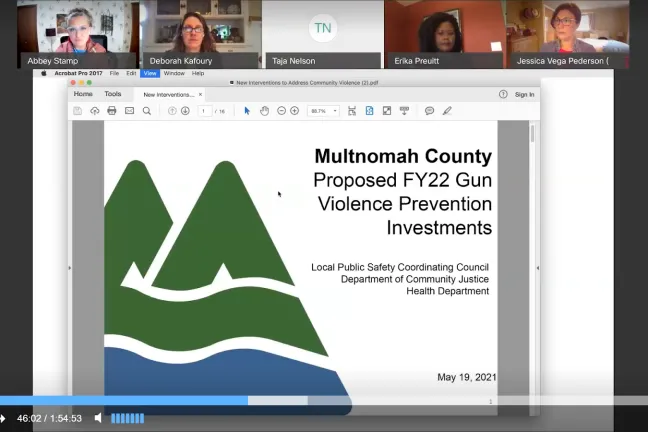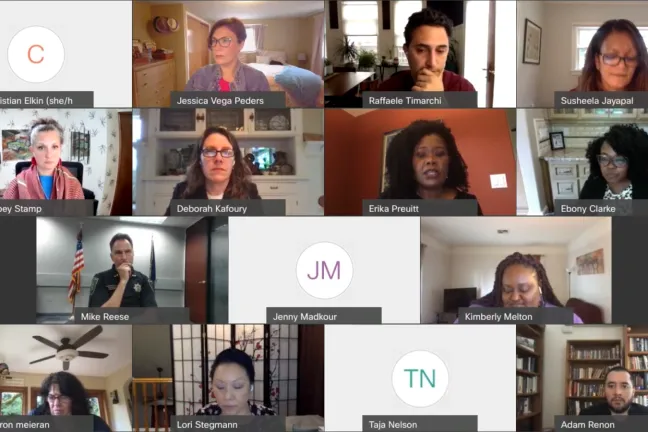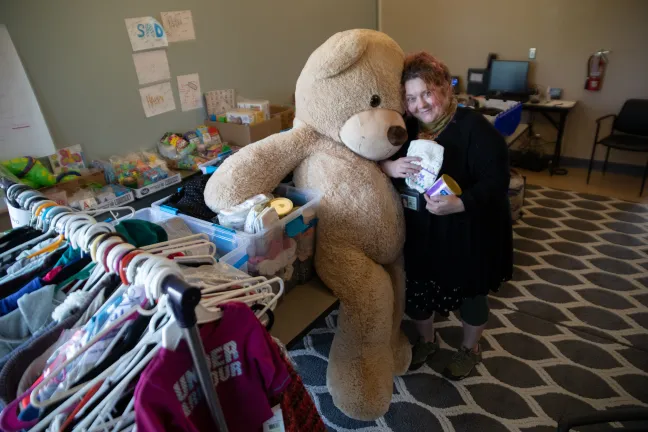The Multnomah County Board of Commissioners received a briefing Wednesday, May 19, on new and enhanced investments to address an epidemic of community violence.
The sharp increase in violence, from domestic violence and interpersonal disputes to skyrocketing incidents of gun violence, “has hurt and traumatized so many people over the last year,” said Multnomah County Chair Deborah Kafoury, who opened the briefing.
As of May 28, Portland has had more than 430 shootings since Jan. 1, including 33 homicides. In the last 12 months before May 28, there were 1,132 shootings in Portland — more than twice the 424 shootings reported over in the preceding 12 months (May 2019 to May 2020).
The frequency and spread of violence have climbed, even amid meetings across the community meant to address the matter. And like so many other crises in the community, violence disproportionately impacts people from Black, Indigenous and other people of color (BIPOC) communities.
Reflecting the County’s cross-departmental approach to responding to community violence, the briefing included representatives from the Local Public Safety Coordinating Council (LPSCC), the Department of Community Justice (DCJ), the Health Department, Sheriff’s Office and the Chair’s office.
“Like a number of other challenges that we’ve faced over the last year, the pandemic has worsened many, if not all, of the existing inequities and disparities that are driving these crises,” said Chair Kafoury.
“It’s taken away opportunities, and it’s disrupted peoples’ sense of connection, stability and security on a scale we haven’t seen in generations. And that’s contributed to the increase in violence in people’s homes and on our streets.”
As the state’s largest safety net provider, spanning health and human services to parole and probation, Multnomah County works upstream to prevent and address crises before they can occur. It also offers downstream interventions and services for people involved in the criminal legal system, and it collaborates with the Multnomah County Sheriff’s Office, District Attorney’s Office, community-based organizations and other vital partners to help suppress violence. The Chair’s Fiscal Year 2022 Proposed Budget seeks an infusion of funds into these kinds of programs and efforts to help interrupt and break cycles of violence, working in partnership with the communities that are harmed the most. On Thursday, June 3, the Board of Commissioners unanimously voted to pass the budget.
The budget proposals were informed by input from more than 1,000 people and organizations, including the Office of Violence Prevention and the Multnomah County Sheriff’s Office, and nearly every elected official in the region. The proposals also reflect feedback from leaders from the faith community, culturally specific community providers, reentry and recovery communities, and people with lived experience in the criminal legal system.
Gun violence, mental health and unmet needs were identified as high concerns among community members.
“There are also many hundreds of years of strained relationships between communities and law enforcement entities,” said Abbey Stamp, executive director of LPSCC, who provided a landscape of the issues in the community. “That is a discussion that continues today, but it’s existed for centuries past.”
“And unfortunately, ongoing widely available firearms in our community continues to be a challenge as we do everything we can to find ways to increase gun safety and decrease gun violence.”
Prevention, Intervention, Collaboration and Resilience
“Our role in addressing the underlying contributors and root causes of gun violence includes systematically reducing risk and increasing resilience in individuals, families and communities,” said Raffaele Timarchi, policy advisor for Chair Kafoury.
“We do this by leveraging resources and services of broad-reaching systems like schools, healthcare providers and social service systems and, of course, working in close partnership with communities themselves to develop shared solutions.”
That approach is reflected through investments in SUN Community Schools, which provides after-school programs and support for parents and families; the Multnomah Stability Initiative, which assists homeless and low-income households; and Bienestar de la Familia, which offers culturally specific services for County’s Latino/x/a communities.
But the budget also includes critical upstream, preventive investments in the form of SUN Youth advocacy programs, which promotes youth development and academic achievement; Multnomah County’s Community and Adolescent Health program, which engages youth in community-led projects such as murals and curriculum for young men; and the Community Healing Initiative Early Intervention program, which works with youth who are on the precipice of entering the juvenile system. Youth and workforce development are also key upstream initiatives.
Downstream investments in interventions, which offer support and resources after violence has occurred, include the Community Healing Initiative, a partnership among Multnomah County’s Juvenile Services Division, POIC + Rosemary Anderson High School and Latino Network that provides culturally specific, holistic, family-based wraparound services to high- or medium--risk youth and their families. Downstream investments also include behavioral health services, domestic violence crisis services and legal services.
Some of these initiatives were underway before the cascade of crises in 2020, but the passage of the budget will bolster the County’s work of addressing the root causes and harms of community violence.
The development of the new set of budget investments were guided by a set of principles that emerged out of community conversations, speakers said. At the forefront was inclusively leading with race, as gun violence disproportionately impacts BIPOC communities. The investments were also developed to represent a multitude of responses, recognizing that there’s no one solution that can address the magnitude of the impact of violence.
Another principle was a focus on collaboration among a range of new and existing partners, including the District Attorney’s Office, Multnomah County Sheriff’s Office, the Department of Community Justice and a broad array of community-based organizations, all of which are critical to the work of suppressing violence.
A public health approach to violence
Interim Health Department Director Ebony Sloan Clarke described roughly $2.8 million in public and behavioral health investments designed to address the root causes of violence.
“A public health approach looks at the root causes of violence not only through the data, but the voices of those impacted,'' Clarke said.
In April, Commissioners declared racism as a public health crisis, joining 170 local governments around the country that have done the same. The declaration acknowledges the role that racism plays in determining health outcomes, and directs more resources to address inequities.
“It’s important to continue to bring forward the racial equity lens and understand systemic racism as a key driver for what we’re seeing,” said Clarke. “And it’s important for us to work to undo some of those system policies and processes that continue to reinforce what we’re seeing at play now.”
The investments Clarke described include:
$1,116,000 in community partnerships & capacity building in Public Health – This new funding will scale up a wraparound model using community health workers in community-based organizations. The County will contract with the Nonprofit Association of Oregon to provide technical assistance to smaller BIPOC organizations, and contract for culturally responsive maternal child health services in the African and Latinx communities. Funding will also go to expand Pacific Islander and Latinx coalitions, as well as the Future Generations Collaborative.
$1,200,000 in a Gun Violence Behavioral Health Response Team – A seven-member team composed of clinicians and peers would provide services for gang-impacted youth and families. The team would work closely with DCJ’s Juvenile Services Division and use therapeutic interventions to address underlying needs.
$170,000 in FaithBridge Trauma and Healing and Recovery – This funding would supplement culturally specific opportunities for women emerging from trauma and/or life transitions to reconnect to faith in a deep and life-transforming way. These women could be emerging from abuse, abandonment, incarceration, and addiction. Eighty-four percent of Black women say religion is very important to them.
$186,000 in culturally specific justice-involved addictions care benefit coordination – This position would work with Black and African American individuals who are on supervision with the Department of Community Justice. The goal will be to connect them to services, including residential treatment, intensive outpatient treatment with supported housing, outpatient treatment, outreach/engagement, recovery mentoring, and recovery support, including connections to housing supports and prosocial/drug-free activities, and help with basic needs.
“Gun violence is complex, and we know the root causes and influences are many. We know the social determinants of health disproportionately impact Black, African immigrant and Latinx people around gun violence,” Clarke said.
“Solutions have to be paired with clinical interventions. We want to develop a team that specializes and understands the nuances so that we can start to really bring forward a real mental health response, while also building in that credible messenger element that is very important.”
Addressing community violence downstream
Erika Preuitt, director of Multnomah County’s Department of Community Justice, described the roughly $1.2 million in investments proposed by the department.
“I want to acknowledge the tragedies and loss in our community. This is close to us because family members and friends are impacted,” said Preuitt. “I want to dedicate this presentation to our families and communities that are really suffering right now. We acknowledge the rise in gun violence in our community, and part of the work that we do is around suppression.”
Preuitt described DCJ’s role in addressing community violence as a downstream intervention, saying, “We’re really working with people who are on probation and parole — our youth and our adults that are on post-prison supervision as well as probation.”
She shared details about new investments that include:
$80,000 to expand the H.E.A.T. (Habilitation, Empowerment, Accountability and Therapy) program – A program designed for African American individuals involved in the criminal legal system. The curriculum is a culturally responsive cognitive behavioral intervention program designed to reflect and address the unique experiences and needs of participants.
$250,000 to expand the Community Healing Initiative – This new funding would expand the Community Healing Initiative (CHI) model to serve additional BIPOC communities as part of a broad strategy to support real-time responses to community violence and other immediate needs.
$500,000 to expand the Elevate Program – The Elevate program is designed for men 18 to 25 years old in the Latinx and African immigrant communities who are affected by gang involvement and gun violence.
$300,000 for Community Health Specialists – Three new Community Health Specialists would work in collaboration with the Health Department and the Department of County Human Services to provide families with safety plans and trauma support for those who have felt the direct impacts of gun violence. This addition would ultimately serve 50 to 60 clients.
$93,000 for a records technician for victim and survivor services notifications – Victims and survivors of crime are disproportionately people of color. Although victims and survivors are the only parties who become involved in the criminal legal system without asking, they often have access to the least amount of support and resources. This funding would provide more people with notifications of court processes and probation violation hearings, among other notifications that victims have a right to request.
“We are very excited that we get to engage with community health specialists who work within the Department of Community Justice,” said Preuitt. “They not only help the people on our caseloads, they also can wrap themselves around families and provide support in our community and really help our clients and families navigate systems that are very complex.”
Community Health Specialists help clients connect to housing and to positive relationships with the Department of County Human Services and the Health Department, she noted, with those relationships leading to help with treatment, safety plans and medical appointments, or just basic needs like diapers for people with children.
Coordination and Collaboration
The work includes cross-jurisdiction collaboration with the East County Rapid Response Team, with members of Multnomah County’s Health Department, Department of Community Justice, Department of County Human Services, Sheriff’s Office and the City of Gresham.
Sheriff Mike Reese described the rapid response occurring in East County and the City of Gresham. Whenever there’s an incident of community violence, partners in the Health Department, Department of Community Justice, Sheriff’s Office and Office of Violence Prevention are immediately on the phone, he said. “Trying to get wraparound services, intervention and really frankly to get assistance to people who may have lost a loved one or are afraid of the next retaliatory shooting.”
The importance of a vision moving forward and a “community free of gun violence” is critical, Reese stressed.
“We’re going to get there through this type of coordination and collaboration,” said Reese. “It isn’t easy work, but my new best friends are at the Health Department, the Department of Community Justice and the Office of Violence Prevention.”
The work is based on a public health approach to address violence. Interventions are evidence-based, community-centered and trauma informed.
“We’re looking at how we treat the symptoms while understanding that we’re working on the cure. The cure is a long-term solution to take firearms out of the mix for people who pose the greatest risk in our community,” said Reese.
The work is broad and comprehensive and some of it is legislative, Reese said.
“I applaud legislators who’ve had the courage to step into this arena and to propose common-sense legislative solutions to gun violence. It also requires intervention strategies and suppression,” Reese said. “Some of that is law enforcement based.... Some of it is the Health Department, community-based treatment providers and resources.”
“Getting upstream so that we can provide meaningful help to people who are at risk.”



